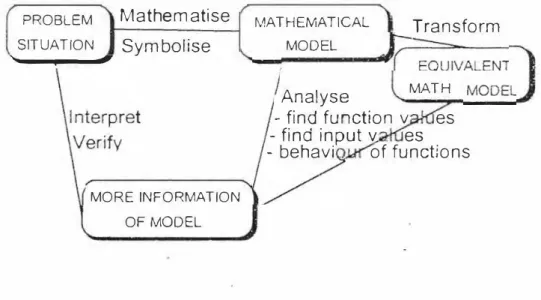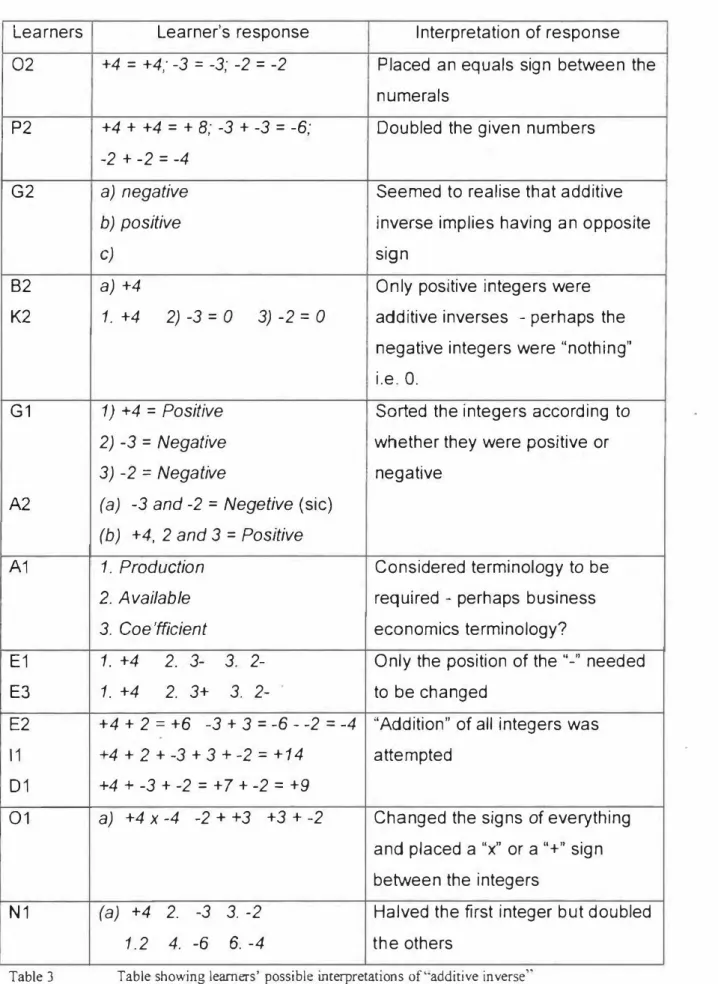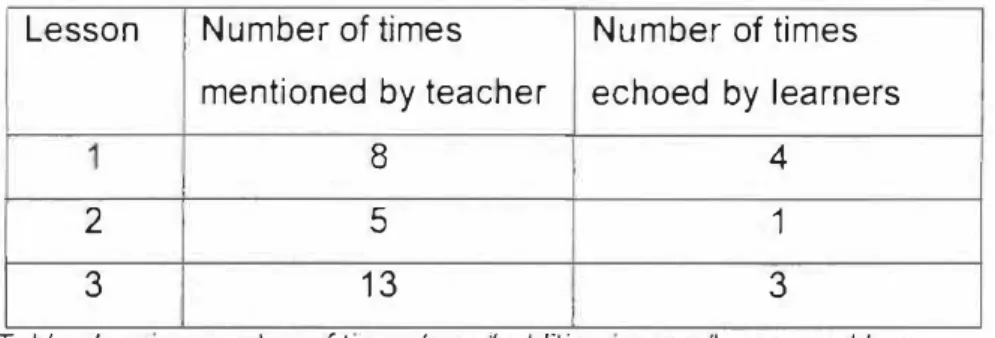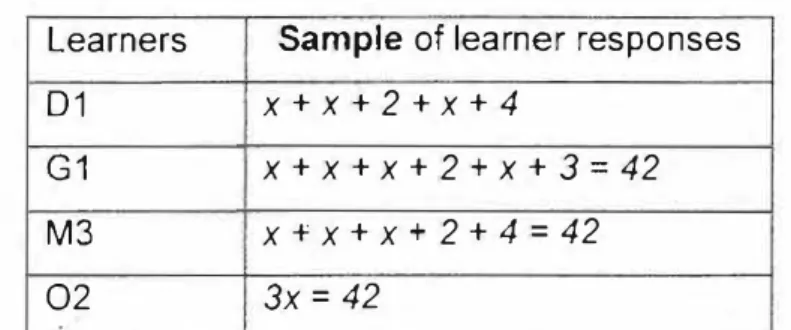Th1is Stu•dy
Rationale
The chosen schools are generally located in and around the immediate vicinity of the urban educational institutions. Knowledge: This study will contribute to the knowledge of the efficiency of mathematics teaching and learning in South Africa.
The schoo,l context
There was no running water in the school and the water tanks were dry. The 455 to 460 students at the school come from five feeder elementary schools in the surrounding area.
- Introduction
- Relevant learning theories
- Lev Vygotsky - Language and thought
- Behaviourism
- Jean Piag.et's kinds of knowledge
- Constructivism
- Teaching mathematics to second language learners
- Assessment
- The teaching of elementary algebra
- The historical development of algebra
- A plhenomeno,Jogical and pedagogical analysis of
The learner is only required to remember one fact, and no understanding of knowledge 1 is necessary." The quality of the test is not dictated primarily by its potential for objective scoring.

Methodology
This case st,udy
During the observations, the researcher sat close to the students in the back of the classroom and focused mainly on what, why, and how the teacher taught mathematics. The teacher was the focus of the observation as the schedule and audio recording used sought to tap into the knowledge, skills and values exhibited by the teacher.
Data collected
The blackboard writing of the teacher became the only written mathematics text perceived by the learners. The teacher did not encourage the learners to omit any of the steps or to check the answers by substitution. The teacher was usually accurate in solving problems chosen by her, but, the problem with no solution (Find three consecutive even numbers whose sum is 27) was solved by the teacher on the board without her reflecting on the accuracy of this solution. The teacher's solution to this problem is shown. in section 4.2.2.3.) The teacher never checked solutions by substitution to see if the solution could be overridden or not.
The standard deviation is 35.24%, which indicates that there is a wide spread of the percentages around the mean value. the middle half of the limbs scored between 23% and 59%. Six students (16% of students who attempted this question) used a variety. to add or subtract the same amount from both sides of the equation. the seven were added to one side of the equation and subtracted from the other side. The students were instructed to manipulate according to the instructions given by the teacher.
The teacher then reminded students of the position of a coefficient in relation to the variable. 1999.The concept of a variable; gauging students' understanding. ed) Proceedings of the Twenty-third International. Does not use students and for 'figuring out' differences and for 'sorting out' differences between their existing between their existing. expression as tools for sorting insights and the new insights and the new differences between their mathematical concepts or processes. the new math concepts or ♦ Does not build on and move on. ♦ Builds and continues. beyond their new their new understanding of the. insight into mathematical concepts or processes.
Analysis of data
- Establishing the lesson context
- The learning environment
- Classroom organisat,ion
- Lesson topics
- Lesson structure
- Language(s) of learning and teaching
- Learner participation and involvement
- Assessment
- Teacher's instructional practices
- Explicitness of mathematics concepts and
- Assistance provided for engagement with
- Provision made for learners to revise
- Assessment of mathematics concepts,
- Teacher's responses to post-lesson teacher
- Number of 'learners absent from the class
- Criteria used for group.ing the learners
- Purpose or goals of lessons
- Resources most used for planning
- Adverse factors affecting the lessons
- Teacher's attitude towards teaching
Eleven students (30% of the students who attempted this problem) solved the equation as required by the teacher. The students did not write the solutions demonstrated by the teacher on the board in their exercise books. The teacher gave the following instructions to the students as she walked around checking solutions.
Discussion
- Establishing the lesson context
- Analysis of text used by teacher
- Teacher's instructional practices
Introduction
The sources used to answer this question were:. textbooks of the test completed on 20 August 1999. textbooks of work completed during lessons and at home. The teacher set up the test, but asked the researcher to write it on the blackboard and start, while the learners completed the test. The teacher asked if the researcher was willing to check the tests, but the offer was declined, as it might interfere with the RGN research process.
Later, the researcher prepared a prospective memo of grades and the .leamers' tests were scored by the researcher. How many more does he need to have 96 sheep? a) Give the inverses of the additions of the following:
Analysis of data
- Using the test prepared by the teacher
- Analysis of test questions
- Analysis of responses to test questions
- Using the !learners' classwork and homework
- The use of the equals sign at the end of a
- The use of arithmetic to solve the
- The setting out of "word" problems
- The interpretation and manipulation of the
- The ability to add and subtract integers
The analysis of the questions is organized based on the points obtained in the test. Three students subtracted the same amount from each side of the equation instead of adding nine to each side. These students did not add or subtract the same amount to each side of the equation.
The most common "type" of balancing used was to add 9 to the left side (LHS) of the equation and subtract 9 from the right side (RHS) of the equation. Perhaps these Jearners did not see the meaning/purpose of adding the additive inverse to each side of the equation. Six learners (16%) of the learners may have used their knowledge of arithmetic to solve the problem correctly, but also attempted the method demonstrated by the teacher unsuccessfully.
Student K1 only subtracted 20 from the left side of the equation leaving the right side as 36, but also gave the solution as.

Discussion
Teacher Strategies and Learners' Performance
Introduction
Analysis of data
- Test question 2 (a)
- Test question 1 (b)
- Test question 2 (b)
- Test question 1 (e)
- Test question 1 (d)
- Test question 1 (c)
- Test question 1 (a)
4 or -2, again after, the three examples were written on the board when the teacher introduced the students to this term in lesson 1. The teacher continued to check the solution and confirm that the students were able to see (understand? ) the procedures as follows: . During lesson 1 the teacher used only decontextualized problems to facilitate the learning of the algorithm.
Using their knowledge of arithmetic, the students easily solved the word problems chosen by the teacher. Although the teacher only mentioned x as an unknown, 32% of the students who tried to solve the test question tried to explain what the unknown represents. The teacher first gave the students the name of the term "multiplicative inverse" and then told them how to find the multiplicative inverse of different numbers.
Here the teacher urged the students to solve the problem quickly using the "short method".

Discussion
Perhaps students used their written solution to the problem 3x + 4 = 10 (similar to 3x + 7 = 25) in their textbooks to reconstruct it for the test. From language to symbolic expression: Students' naming problems. ed) Proceedings of the Twenty-third International Conference on Psychology. Notes from a 1995 refresher course conducted by Smit, S. for Standard 5 teachers in KwaZulu. Natal entitled "Problem Centered Learning". eds) Proceedings of the twenty-second international conference on the psychology of mathematics education.
The construction of an algebraic concept through conflict. ed) Proceedings of the Twelfth International Conference. 34; Written conversation form" as an initiator for Teachers' change•ge. ed) Proceedings of the Twenty. Third International Conference for the Psychology of Mathematics Education. A cuhtural perspective. ed) Proceedings of the Twenty-third International Conference for the Psychology of Mathematics Education .
In Zaslavs'ky, 0 (ed) Proceedings of the Thieves. Third International Conference on the Psychology of Mathematics Education.

Concluding Remarks
Recommendations and conclusion
Allowing students to develop their own strategies, together with their peers, and then as a whole class through discussions, would allow for the development of a manageable plan for solving linear equations. If we want to focus our instruction on improving student thinking, teachers using the NCTM standards templates should consider the following: These recommendations can only be achieved by encouraging mathematics teachers to develop their teaching skills. substantive knowledge, although appropriate in serve mathematics education courses or by providing incentives for teachers to belong and become active members of a relevant mathematics teacher.
Furthermore, validity would be best achieved if the teacher and students controlled the content of this study. As a teacher-educator, the researcher has gained valuable insight into recent ideas about teaching and learning algebra, which will undoubtedly enrich education. student-teachers of mathematics from the researcher. Objectives in teaching/learning mathematics. eds) Mathematics education for pre-service and in-service eds) Mathematics education for pre-service and fn. Support the participation of the English language. Different letters represent different numbers. eds) Mathematics education for preschoolers. Let's not teach algebra to 8th graders.
Over the Hills and Far Away
It does not provide students • Provides students ♦ Provides students ♦ Provides students ♦ Provides students with opportunities to practice using opportunities to practice opportunities to practice using opportunities to practice using opportunities to engage in new math concepts or new math concepts new math concepts or new math concepts or exercise using new math. I exercises that are set to • Does not provide students with higher levels of independent .. too high/too low initial opportunities to develop competence by • Helping students develop the point for students.) higher levels of independent opportunities to use new mathematics higher levels of independence. competence by giving them concepts or processes in terms of competence by giving them opportunities to use new mathematics of incremental complexity. For learners, opportunities for concepts or processes in the sense of an example, engaging students in practice using new mathematics of increasing complexity. using increasingly complex concepts or processes in expressions. examples that help them with progressive complexity. . develop their understanding.
Provide learners who demonstrate and use of new concepts or .. processes in progressively proficiency / difficult ways.) mastery with opportunities to. Not provided to learners who use new math concepts or demonstrate competency I processes in a variety of other mastery of application opportunities. For example, complete additional activities using and applying concepts using new math concepts or and process to solve each day/. processes in a variety of other real-world problems.) applications.
Does not encourage students • Encourages students to • Encourages students to discuss • Encourages students to discuss ♦ Encourages students to discuss to discuss new mathematics check/correct each other's new mathematics concepts or the mathematical concepts or the mathematical concepts or concepts or processes with reply.
